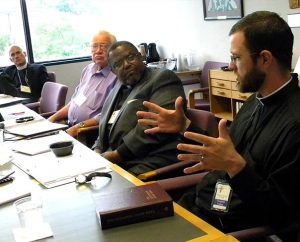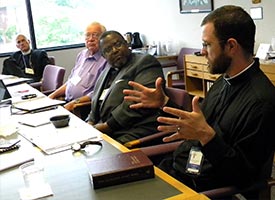By Joe Isenhower Jr.
ST. LOUIS — At its May 30-31 meeting here, the Synod’s Board for National Mission (BNM) welcomed two new members, continued work on refining policies and on a theological statement for mission, and heard reports from several staff members, leaders of LCMS auxiliaries and Synod President Rev. Dr. Matthew C. Harrison.
First, the BNM met in a May 30 joint session with the LCMS Board for International Mission, when staff of the Office of National Mission (ONM) and Office of International Mission (OIM) provided overviews of their work.

ONM Executive Director Rev. Bart Day reported to the joint meeting for his staff; and reporting for the OIM were its Executive Director, Rev. Randall L. Golter; Associate OIM Director Rev. Dr. Edward Grimenstein and the Rev. Dr. Albert B. Colver III, the Synod’s director of Church Relations and the OIM’s director of Regional Operations.
Day told the boards that the ONM has “programmatically … divided our work into ‘Witness, Mercy and Life Together’ ” (the Synod’s three-fold emphasis).
To “deliver services,” he explained, each of the 19 ONM ministries aims toward church revitalization — particularly as it applies to three demographics: rural/small-town, urban/inner-city and campus settings.
He emphasized that as the LCMS Bylaws stipulate, “the Office of National Mission is here to support and facilitate the work of the [35 LCMS] districts, to serve their churches, schools and workers.”
In the OIM report, Golter said that when he travels “around the church,” he “realize[s] that people love mission because the Lord loves mission. And they love to hear that the church is sending missionaries out into the world.”
Grimenstein told the two boards that his primary responsibility “is to oversee the physical operations at the St. Louis [offices] — to make sure that everything is moving along in support of our regions and our regional directors and that they’re receiving all the support they need.”
Closely tied to that work, he said, is developing and implementing protocols “that we need to facilitate” the work. They include protocols for debriefing missionaries, assessments, education for missionaries, for international congregations, and for vicarages and first calls to the mission field.
Collver explained that his primary responsibility is “to serve the president in the position of church relations.” He continued that his work in relation to the OIM is mainly with the five regional directors, to help them “in terms of how they interact with church partners in their work on the mission field.”
Beginning its separate meeting, the BNM welcomed two new members — Julia Habrecht, headmaster of Immanuel Lutheran School in Alexandria, Va., who replaces former board member Dr. Jim Tallmon; and the Rev. Dr. Alfonso Espinosa, pastor of St. Paul Lutheran Church, Irvine, Calif., who replaces the Rev. C. Bryan Wolfmueller. The board also bid farewell to the Rev. Thomas E. Engler, who has accepted a call out of the region from which he was originally chosen as a BNM member. Tallmon also ¬moved out of the region he represented and Wofmueller resigned to devote more time to his congregation.
In his report to the board, Day briefly highlighted an ONM effort under way in which 12 LCMS districts will serve as “pilots” for revitalization, in line with a request from the 2013 Synod convention.
“They’re all very excited,” Day said of those districts’ involvement.
Responding to a request from the LCMS Commission on Constitutional Matters, the BNM approved edits to several of its policies, to make clear that the board and staff primarily serve districts. It also developed several new policies for Black and Hispanic Ministries.
Staff, auxiliary reports
Three ONM staff members reported to the board on the work for which they are responsible — the Rev. Heath R. Curtis, coordinator of Stewardship Ministry; the Rev. Steven D. Schave, director of Urban/Inner-City Ministry; and the Rev. Joel Hempel, director of Specialized Pastoral Ministry.
Curtis coordinates ONM Stewardship Ministry along with Assistant Coordinator Rev. Nathan Meador.
He told the board that he and Meador are working to reach pastors of congregations that are not actively engaged in “teaching stewardship.” He added that the “best figures available” show that about 70 percent of LCMS congregations’ pastors fall into this category. He explained that the other 30 percent are “doing something intentional to teach from the Word of God about generosity and funding the mission.”
Curtis continued that ONM Stewardship’s “goal is to expand the way we talk about stewardship — the way we teach it from the Word of God. We want pastors to know that this is something they can do in a theological way.”
He then explained the stewardship approach that he and Meador are taking, which emphasizes “Law and Gospel, vocation and sanctification.”
“Vocation is native to Lutheranism,” Curtis said. “It’s robustly biblical. It’s absolutely where stewardship fits and Lutheran pastors can get excited about teaching in this way.”
In his report, Schave noted that “right now, cities are outpacing their suburbs” in population growth.
He observed that the 2013 Synod convention’s adoption of Resolution 3-07A “made it a mandate that we’re not going to lose more ground in the city. … These are our beachheads for mission work and we have to continue to strive in the city because there is just too much at stake if we don’t do that.”
Schave said it is important for the Synod to recruit and prepare future pastors, teachers, deaconesses and others for urban ministry, because “it takes everyone working together as urban missionaries.”
And he noted the “vital importance” of urban churches spearheading community development by working with neighborhood associations and fostering partnerships with corporations to revive neighborhoods, including through “creative funding.”
“We all need to work together to bring the light of Christ into our mean streets and dark alleys, to bring new life to our inner-cities,” Schave said.
Hempel spoke to the board about specialized pastoral ministry in the LCMS and the 2013 Synod convention’s adoption of Resolution 2-05B, which allows the BNM to issue calls to those serving in such ministries.
He pointed out that specialized pastoral ministry in the Synod includes about 350 individuals who are mostly institutional and emergency-services chaplains, but also pastoral counselors and clinical pastoral educators (who teach others how to do specialized pastoral ministry).
Hempel referred to the convention’s adoption of the resolution as “a very powerful way of saying to somebody, ‘You belong in this church body and we recognize you as one of our ministers of God in the Gospel serving in this community of faith.’ ”
The Rev. Dr. Mark Larson provided an overview and update of the work of Lutheran Hour Ministries (LHM) — one of the two LCMS auxiliaries. He is director of LHM’s United States Ministries.
“Our focus is really on outreach,” Larson told the BNM. “More and more, we want to make sure that everything we are doing is focused on outreach and evangelism.
“Our mission statement, of course, is ‘Bringing Christ to the nations and the nations to the church,” Larson said, “especially through media, but also through personal witness. [And] we always want to have the goal that people are getting connected to local congregations.”
He then spoke of LHM’s many resources, in addition to its “flagship” radio program, “The Lutheran Hour.” LHM works in 30 countries.
Larson added that he appreciates meetings that he and Day have together “to keep each other informed” and referred to a gathering of ONM and LHM staff members last December as “very, very productive.”
He noted that the ONM’s Domestic Violence Task Force is working with LHM to develop a resource booklet, as one of the ways they work together.
“We’ll look for more ways to partnership,” Larson told the board. “More ways to lift up each other’s ministries.”
Kay Kreklau, president of the Lutheran Women’s Missionary League (LWML) — also a Synod auxiliary — told the BNM of the LWML’s enthusiastic support for ONM ministries and events.
As an indication of that support, Kreklau said members of the LWML executive committee have expressed “keen interest” in attending this month’s LCMS Black Ministry Family Convocation in Kansas City and the National Rural & Small Town Ministry conference in November (and also in Kansas City).
“Our Lord has blessed us abundantly in our 72 years,” Kreklau said of the LWML. “Throughout those years,” she said, “the LWML, through God’s grace, has donated to missions over $100 million,” collected via its “mite box” member offerings.
She said the LWML conducted a recent survey that found “the LWML is trusted. We knew it. … Even people who are not LWML members know that those funds from mite boxes are going to missions — they’re not being wasted.”
At its 2013 convention in Pittsburgh, the LWML adopted 18 separate mission grants totaling $1.8 million. Kreklau said that the 2013-14 national mite goal is $1.83 million. “And in addition, each LWML district has its own mite goal.”
“Our task,” Kreklau said, “is to encourage LCMS women to be rooted in God’s Word and to live out our response to God’s grace through mission, service and fellowship with other women.”
“So, keep us in prayer,” Kreklau asked the BNM members, “as we keep our church in prayer.”
Several board members expressed thanks for the work of LHM and the LWML.
ONM ‘starting to pump’
“I see National Mission really starting to pump,” Harrison told the board.
He also noted that “things are going pretty well” for the Synod.
Harrison said that “most significant to this board “ is a study he has asked the LCMS Rosters and Statistics department to conduct on the decline of LCMS membership statistics over the past 40 years.
“A number of things are starting to become clear from this study” – that “the Synod is challenged most in the most secular areas of the country and that economic factors come into play.”
“The biggest factor across the board is that we are having far fewer children and we are getting married much later,” Harrison said. “Then, of course, [another] reason for the decline is that we have failed to reach out to non-Anglo communities.”
Harrison spoke of the Synod’s “language change” from German to English over the years.
“I think it’s time to look strategically at another language change — mainly to Spanish,” he said.
“We’re looking at how we can address and [offer] the most rational response to this current situation,” Harrison said. “The church doesn’t grow because of what the national office does. The Missouri Synod grows because people have babies, get them baptized, share Christ with their communities and plant the church.”
The BNM also devoted time at its May meeting toward finishing its work on “A Theological Statement for Mission in the 21st Century.” That work is toward fulfilling Resolution 1-031A of the 2013 Synod convention, which called for a Synodwide study of the document after the two mission boards complete their work on it.
The next meeting of the LCMS Board for National Mission is scheduled for Sept. 26-27.
Melanie Ave assisted with reporting for this story.
Posted June 25, 2014 / Updated June 26, 2014
